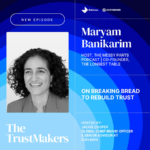By Michael Lamb, Creative Strategist at M&C Saatchi Talk
Before the pandemic very few brands could claim that they truly understood how their customers felt about a wide range of social issues, never-mind consumers from diverse and minority audiences.
However, the support offered by many brands throughout the crisis meant marketers had to speak with people and communities beyond their core customer base.
So, at a time when communities are rebuilding in a post-pandemic world, can marketers continue to engage with a wider range of people and learn how to create meaningful conversations with old and new communities?
Conversations have the power to change the world. From creating and building connections, to spreading culture and attracting attention, conversations that start small can snowball into global movements.
However, the identifying parameters of ‘a conversation’ are changing. They don’t just happen verbally anymore. Digitalisation, especially in the media landscape, has been accelerated by the pandemic, and now more than ever, we must pay attention to how we can reconnect with the people around us.
The turbulence of the past few years has changed society dramatically and the marketing sector is no exception. Brands have had to overhaul their priorities when it comes to communicating with consumers and in turn it’s proven the importance of conversations that are meaningful. The latest findings from our recent consumer research, The Art of Conversation, help prove this as it revealed that a quarter of consumers are more likely to purchase from a brand that speaks about issues that matter to them and a further 61% say conversations with a brand should be supportive, knowledgeable, and inclusive.
Authentic Messaging at the Heart of Conversations
The best conversations don’t start with what a commercial entity wants to talk about, they start with what an audience wants to hear. Brands must have their finger on the pulse of trends, stories, and opinions and before entering a conversation, they must be careful how they approach it and what public opinion is.
One of the fundamental pillars of meaningful conversation is authenticity. We have seen a growing shift in power, moving away from businesses and towards consumers instead. With this in mind, brands now must try harder than ever to identify the conversations and trends in culture that matter most to consumers.
To ensure the conversations are meaningful, authenticity must sit at the heart of the company itself – they can’t be cooked up in the marketing department – they must have a resonance and relevance to how the company operates, especially the values and the way it manages interactions with all stakeholders. Real expertise and credentials are required before commenting on a topic or it risks damage to the brand – brands are told to stay in their lane for a reason. The value of authenticity stems from a need for trust. Consumers must feel a sense of trust in a brand to connect and engage with them on a deeper level.
This is simultaneously linked with a brands credibility in the space they work in – you only must look at Pepsi’s (now legendary) ill-fated advert with Kendall Jenner to see that without pedigree and a lack of meaningful commitment, consumers will see through attempts to hop onto trends and social causes.
Engaging With Audiences in the Right Way, in the Right Place, at the Right Time
Now more than ever, brands want to speak up around cultural and societal issues that matter, especially given increased awareness and frustration around the need for diversity and inclusion in business and indeed marketing. Yet, it’s also one of the hardest times to achieve this. There can often be real disconnect between big brands and consumers, especially with issues such as Brexit and the rise in living costs putting a strain on consumer-brand relationships.
A good way to test the action plan of a brand is to look inwards first. Garner insights from internal stakeholders and wider employees before taking anything external. Getting a feel for what employees are interested in can help highlight areas for improvement. As we all know, consumers are more than willing to call out a brand when an approach is disingenuous.
By adopting a policy that places focus on internal conversations first, brands can temperature check the conversations that matter, ready to be addressed externally too. These topics can then be backed up and further developed by engaging relevant journalists and influencers in the specific space. Too often brands rely on the same set of journalists and influencers to tell their story, when they aren’t authentic to the topic. But by working with community-based influencers, brands can highlight authentic voices to help tell the right stories.
Adopting this approach will ensure conversations are rooted in evidence and communicated with trust. Nike is a great example as it’s an expert in integrating campaigns. Whether it’s balancing high-profile female footballers and amateur local footballers, Nike understands the value of authenticity.
Getting your platform right is important too. The Art of Conversation report also found that Gen Z consumers are six times more likely to engage on TikTok than older generations. Brands must tell the right story on the right platform whether its Twitter or TikTok. A one size fits all approach just doesn’t work.
Embracing Meaningful Conversation
Ultimately, the consumer-brand relationship is everchanging, yet what remains consistent is the need to spot the conversations that matter. When working to achieve this, brands must consider what success looks like and in turn hold themselves accountable. It’s about long-term, sustainable change.
Brands need to meet the growing expectations of consumers to keep them engaged. But the reality is consumers are real people, not data points. And they want to see real-life change that bridges the gap between a brand promise and their reality.
This can only happen if agencies and clients work together to understand a target audience to ensure they’re able to create authentic conversations and campaigns that create ‘permission’ to engage on a topic, while positively impact consumers and stakeholders alike.











